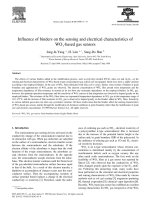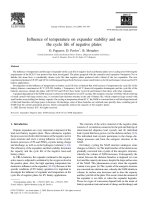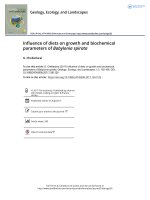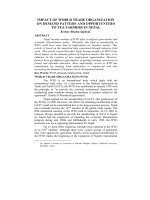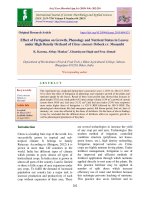Influence of age-class on seed characterisation and tamarind kernel powder yield in tamarind (Tamarindus indica L.)
Bạn đang xem bản rút gọn của tài liệu. Xem và tải ngay bản đầy đủ của tài liệu tại đây (243.96 KB, 5 trang )
Int.J.Curr.Microbiol.App.Sci (2017) 6(6): 1867-1871
International Journal of Current Microbiology and Applied Sciences
ISSN: 2319-7706 Volume 6 Number 6 (2017) pp. 1867-1871
Journal homepage:
Original Research Article
/>
Influence of Age-Class on Seed Characterisation and Tamarind Kernel
Powder Yield in Tamarind (Tamarindus indica L.)
C.N. Hari Prasath*, A. Balasubramanian and S. Radhakrishnan
Department of Silviculture, Forest College and Research Institute, Tamil Nadu Agricultural
University, Mettupalayam - 641 301, Tamil Nadu, India
*Corresponding author
ABSTRACT
Keywords
Kernel, Seed coat,
Seed tannin,
Tamarind kernel
powder, Tamarind
Seed.
Article Info
Accepted:
23 May 2017
Available Online:
10 June 2017
An experiment was conducted to study the seed coat to kernel ratio, seed coat
tannin and tamarind kernel powder (TKP) outturn in different age-classes viz., age
class of 10-20 years, age class of 20-30 years, age class of 30-40 years, age class
of 40-50 years and age class of 50-60 years at Paiyur, Kaveripattinam taluk,
Krishnagiri district of Tamil Nadu, India. Among the five age-classes, the kernel
(Endosperm) content was maximum (77.89 %) in age class of 40-50 years and
minimum (68.34 %) in age class of 50-60 years and vice versa in seed coat
content. In seed coat tannin, the age class of 10-20 years was exhibited maximum
with 285.13 mg g-1 and minimum in age class of 20-30 years (259.66 mg g-1). The
kernel was pulverised and it was subjected for tamarind kernel powder outturn
(TKP). The tamarind kernel powder (TKP) outturn was exhibited highest in age
class of 40-50 years (80.96 %) and lowest in age class of 50-60 years (75.78 %).
On concluding the study, the age class of 40-50 years bestow maximum in kernel
content in seed and tamarind kernel powder outturn, so hence it can be
recommended for tamarind kernel powder yield in seed raised plantation.
Introduction
In the recent years, there has been a steady
increase in the potentials of the world’s plant
resources and many investigations are
screening towards new applications in science
and industry. Among these plant resources
and wealth, tamarind has been well known in
India, since ancient times for uses. Tamarind,
Tamarindus indica L. is a multipurpose
tropical fruit tree used primarily for its fruits
and seeds processed for non-food uses.
Tamarind is a long-lived, large, evergreen or
semi-evergreen tree, 20-30 m tall with a thick
trunk up to 1.5-2 m across and up to 8 m in
circumference. Tamarind thrives under a
maximum annual temperature ranging from
33-37°C to a minimum of 9.5-20°C and
grows well in loamy, deep and well drained
alluvial soil.
Especially, the tamarind seed based products
are gaining more importance in textiles and
pharmaceuticals industries due to its binding
and sizing properties. The tamarind seed is
used for preparation of tamarind kernel
powder. It is prepared by decorticating the
seed and pulverising the creamy white
1867
Int.J.Curr.Microbiol.App.Sci (2017) 6(6): 1867-1871
kernels. The decorticated seed is ground by
machines to the required mesh size for
obtaining a yield of 55-60 per cent. The
powder tends to deteriorate during storage
under humid conditions; hence storage in a
dry place under moisture proof containers is
important. Mixing with 0.5 per cent of sodium
bisulphite before packing will prevent
enzymatic deterioration (Reddy et al., 2013).
The characteristic of a good tamarind seed
powder is that it should have flavouring,
when dissolved in water and be free of any
burnt or other undesirable flavours, good
keeping quality and free from any insect
pests, fungal growth or extraneous materials.
In India, TKP is used as a source of
carbohydrate for the adhesive or binding
agent in paper, textile sizing, weaving, jute
products as well as textile printing (Khoja and
Halbe, 2001).
Tamarind seed gum (TSG) is a new
formulation derived from the tamarind kernel
powder. The main component of tamarind
seed gum was identified as a non-ionic,
neutral, branched polysaccharide consisting of
a cellulose-like backbone that carries xylose
and
galacto
xylose
substituents
(Pongsawatmanit et al., 2006).
In conformity with the above principle, the
study was aimed to study the influence of age
on seed properties and tamarind kernel
powder outturn.
Materials and Methods
The tamarind leaves collected in different
age-classes viz., Age class of 10-20 years, age
class of 20-30 years, age class of 30-40 years,
age class of 40-50 years and age class of 5060 years were taken from Paiyur,
Kaveripattinam taluk, Krishnagiri district of
Tamil Nadu. The tamarind pods collected
from different age-classes were processed and
analysed at Forest College and Research
Institute, Mettupalayam during 2014 - 2016.
Survey has been made to collect tamarind
fruits from 5 different age-class trees, where
one kilogram of pod from each age-class was
taken for pod fractionation. The pods were
broken carefully and fractionated into pod
shell, fibre, pulp and seed. Freshly collected
fruits were de-pulped and seeds were
separated from the rind of the fruits carefully.
The seeds collected were cleaned and washed
in water to remove all the foreign materials.
The seeds obtained through pod fractionation
in five different age-classes were used for
studying the tamarind seed coat to kernel
content, seed coat tannin and tamarind kernel
powder outturn.
Tamarind seed coat to kernel content
Removal of testa from the seed is a difficult
process, the testa was tenaciously held to the
endosperms and it should be removed without
damage to endosperm. The peeling of testa
from the seeds was done by standardised
decortication process. The content of seed
kernel to testa was estimated by the formula
described by Doucette et al., (2001) and
expressed a percentage.
Weight of the seed at outlet
Seed recovery (%) = -------------------- X 100
Total weight of the seed lot
Seed coat tannin
The tamarind seed coat powder of 0.5 grams
was weighed and transferred into 250 ml
conical flask. Then, 75 ml of water was added
and heated gently for 30 minutes. Further the
solution was centrifuged at 2,000 rpm for 20
min and collected the supernatant in 100 ml
volumetric flask and make up the volume. 1
ml of the sample extract was transferred to a
100 ml volumetric flask containing 75 ml
water. The solution was added with 5 ml of
Folin-Denis
reagent
(Sadasivam
and
Manickam, 1992), 10 ml of sodium carbonate
solution and dilute to 100 ml with water and
1868
Int.J.Curr.Microbiol.App.Sci (2017) 6(6): 1867-1871
shake well. The absorbance in double beam
UV spectrophotometer was recorded at
700nm after 30 min.
Results and Discussion
Tamarind kernel powder outturn
The tamarind seed comprises the seed coat or
testa of 20-30 per cent and the kernel or
endosperm
of
70-75
per
cent
(Shankaracharya, 1998). The above study
results concomitant result of present
investigation, which concluded that seed in
age class of 50-60 years has accounted
highest seed coat of 31.66 per cent and
highest kernel content of 77.89 per cent in age
class of 40-50 years (Table 1).
After the separation of seed coat form seed,
the endosperm obtained was subjected for
preparation of tamarind kernel powder. The
decorticated endosperm was pulverised and
tamarind kernel powder was prepared.
The quantity of tamarind kernel powder
(TKP) obtained from 1 kg of seed reflects the
powder yield.
Seed coat to kernel content
Tannin content in tamarind seed coat
During the present study, 1 kg of cleaned
tamarind kernel was taken and subjected for
grinding then the quantity of tamarind kernel
powder obtained was estimated by the
formula followed by Thyagarajan (1996) as
described below. The values were expressed
in percentage.
Tamarind kernel powder (%) =
Weight of the seed powder at outlet
----------------------------------X 100
Total weight of the seed lot
Statistical analysis
The experimental data were subjected to
statistical analysis for the possible
relationship between the different parameters
and analysis of variance employing
randomized block design as described by
Panse and Sukhatme (1985). The data were
analyzed using AGRES software developed
by Tamil Nadu Agricultural University
(TNAU) Coimbatore. The data on every
parameter were analyzed separately in single
factor analysis, using AGRES software. Then
the values of critical difference (CD) at 0.05
and standard error deviation (SEd) were given
in the respective tables (Tables 1 and 2).
Tannins are complex secondary metabolites
having various medicinal properties but
difficult to isolate in pure form.
The age class of 10-20 years was accounted
maximum tannin content of 285.13 mg g-1
followed by age class of 30-40 years (278.01
mg g-1), age class of 50-60 years (276.49 mg
g-1) and age class of 40-50 years (266.63 mg
g-1). The minimum tannin content of 259.66
mg g-1 was recorded in age class of 20-30
years (Table 2). Tamarind seed is the raw
material used in the manufacture of tamarind
seed kernel powder (TKP), polysaccharide
(jellose), adhesive and tannin by Marathe et
al., (2002).
Tamarind kernel powder outturn
The present study was carried out to study the
response of different age-classes on outturn of
tamarind kernel powder. The highest tamarind
kernel powder outturn was attained from the
seed harvested in the age class of 40-50 years
with the outturn of 80.96 per cent followed by
age class of 30-40 years with TKP outturn of
80.34 per cent (Fig. 1).
1869
Int.J.Curr.Microbiol.App.Sci (2017) 6(6): 1867-1871
Table.1 Seed coat to kernel content of tamarind seed in different age-classes
Sl.No.
1
2
3
4
5
Age-classes
(years)
10 – 20
20 – 30
30 – 40
40 – 50
50 – 60
Seed coat (%)
25.46
27.95
23.73
22.11
31.66
Kernel (%)
74.54
72.05
76.27
77.89
68.34
1.003
2.127
1.003
2.127
SEd
CD (0.05)
Table.2 Tannin content of tamarind seed coat in different age-classes
Sl.No.
1
2
3
4
5
Age-classes
(years)
10 – 20
20 – 30
30 – 40
40 – 50
50 – 60
Tannin content (mg g-1)
285.13
259.66
278.01
266.63
276.49
SEd
CD (0.05)
0.645
1.369
Fig.1 Effect of different age-classes on outturn of tamarind kernel powder
The poor outturn of tamarind kernel powder
was obtained in age class of 50-60 years. The
above study was substantiated with Nair and
Fahsa (2013) and Klahal et al., (2013) on
tamarind kernel powder outturn. The age class
of 40-50 years was found superior in kernel
1870
Int.J.Curr.Microbiol.App.Sci (2017) 6(6): 1867-1871
content of seed and tamarind kernel powder
(TKP) outturn in tamarind plantation.
However, the age class of 50-60 years was
poorly performed in kernel content of seed
and tamarind kernel powder (TKP) outturn
and hence this age class should be avoided
during TKP production.
Acknowledgement
The authors acknowledge ICAR-Indian
Institute of Natural Resins and Gums, Ranchi
for funding the network research project on
“Harvesting Processing and Value Addition
of Natural Resins and Gums – Tamarind Seed
Gum”.
References
Doucette, K.M., K.M. Wittenberg and W.P.
Mccaughey. 2001. Seed recovery and
germination of reseeded species. Journal
of Range Management, 54: 575-581.
Khoja, A.K. and A.V. Halbe. 2001. Scope for
the use of tamarind kernel powder as a
thickener in textile printing. Man Made
Textiles in India, 44(10): 403-407.
Klahal Kittiya, Janya Pikul Wancheng
Sittikijoythin
and
Rattanphol
Mongkholrattansit. 2013. Thickening
agent based on Tamarind seed gum for
disperse
printing
of
polyester.
International
Textile
Conference,
Bangkok, Thailand.
Marathe, R.M., U.S. Annapure, R.S. Singhal
and P.R. Kulkarni. 2002. Gelling
behaviour of polyose drom tamarind
kernel
polysaccharide.
Food
Hydrocolloids, 16: 423-426.
Nair, Bidu R. and K.S. Fahsa. 2013. Isolation
and characterisation of mucilage from
some selected species of Abelmoschus
Medik. (Malvaceae) and their application
in
pharmaceutical
suspension
preparation. International Journal of
Pharmacy and Pharmaceutical Sciences,
5(1): 398-402.
Panse, V.G., and P.V. Sukhatme. 1985.
Statistical methods for agricultural
workers (Ref. Edn.). ICAR, New Delhi.
Pongsawatmanit, R., T. Temsiripong, S. Ikeda
and K. Nishinari. 2006. Influence of
tamarind seed xyloglucan on rheological
properties and thermal stability of tapioca
starch. Journal of Food Engineering, 77:
41-50.
Reddy, Y.N. 2013. Physiological implications
of high density planting and canopy
management in fruit crops. Lead paper
presented in National Seminar on High
Density Planting in Fruit Crops at
Coimbatore, Tamil Nadu Agricultural
University.
Sadasivam, S. and A. Manickam. 1992.
Biochemical methods, New Age
Internationals (P) Ltd. Publication. 2nd
edition. pp. 11-199.
Shankaracharya, N.B. 1998. Tamarind Chemistry, Technology and Uses - a
critical appraisal. Journal of Food
Technology, 35(3): 193-208.
Thyagarajan Victor, S. 1996. Process
development of adhesive from tamarind
kernel powder. M.Sc Thesis, Tamil Nadu
Agricultural University, Coimbatore. Pp.
20-25.
How to cite this article:
Hari Prasath, C.N., A. Balasubramanian and Radhakrishnan, S. 2017. Influence of Age-Class
on Seed Characterisation and Tamarind Kernel Powder Yield in Tamarind (Tamarindus indica
L.). Int.J.Curr.Microbiol.App.Sci. 6(6): 1867-1871.
doi: />
1871
